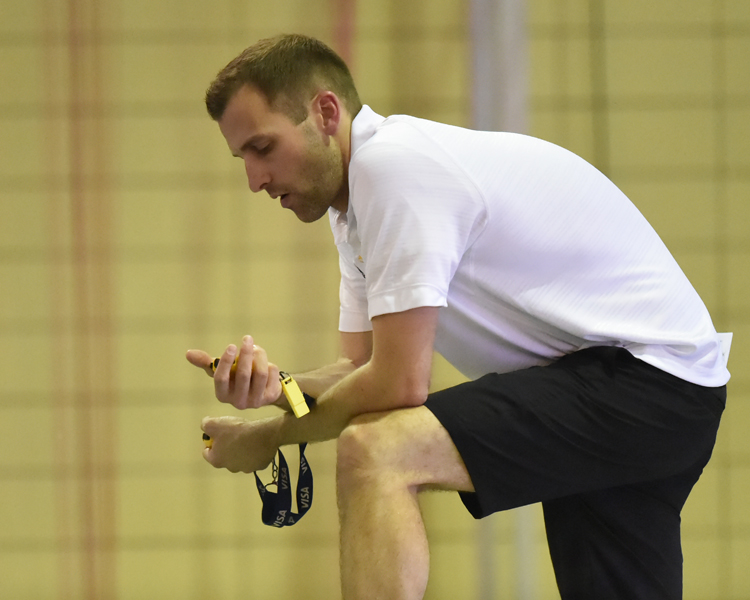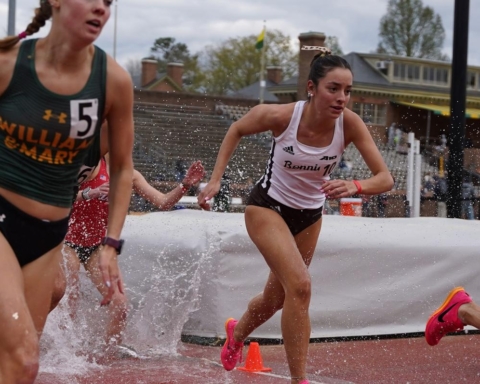By Ryan Signorino
Staff Writer
The Atlantic 10 Swimming and Diving Championships are fast approaching, and for women’s head coach Brian Thomas, it will be his first conference meet with the team.
After being hired last April, Thomas has revamped the women’s swimming program. He had the swimmers focus more on swimming at race pace during practice. Thomas said he is eager to see the results of the team’s new training regimen once the women swim at A10s.
“Just like anybody else in a new position, starting out you have to train yourself to exercise some patience, because you want everything immediately,” said Thomas. “That being said, our group of people here, not only on the team but our administration, [Coach Sean McNamee and Coach Bill Williams] on the diving side, we work really well together. They’ve been a tremendous help to me in terms of learning the different processes here and getting things moving in the right direction with our team.”
Thomas said while he has been happy with results thus far, it is too early to say whether his first season at the helm was a success.
“I haven’t really sat back and thought about that too much,” said Thomas. “Right now, we’re just trying to get ourselves prepared to swim as fast as possible in February.”
The team has two meets remaining, today at Buffalo and Saturday against Niagara at home. Once those are over, the team will begin a process leading up to A10s known as tapering.
“In a sport like ours, in which there is a strong aerobic component, along with strong anaerobic components, it becomes important to let the body rest and recover fully before we compete at a high level,” said Thomas. “It increases power output, more than anything, that’s probably the biggest change, which is really important for our shorter races.”
As collegiate athletes, there is a time management aspect to balancing training, workouts, homework and sleep. Since tapering cuts down on how much the team trains, it allows the student-athletes more time to rest.
“They become accustomed to managing their school schedules with their training, which is very, very intense,” said Thomas. “To be able to back off of that allows them to get more sleep, to feel like they’re focusing in on the details within their swimming at a higher level.”
Thomas said the physiology of the taper process is proven, but it takes having the mental, physical and emotional components all together.
“It’s really intertwined, and the most important thing is probably allowing them to get more rest and recovery time, which allows for a huge increase in power output in the water,” said Thomas.
One of the significant racing components the team has been implementing in the past few weeks is charting everything the athletes are doing in order to track their progress on a weekly basis.
“It allows us to see where they are and make any adjustments that we think are necessary. It’s a very individualized approach. There’s five different groupings of the 20 girls in the water, so it’s fairly individualized,” said Thomas. “It allows us to see those changes as they happen, and you do see an increase in performance in workouts as the volume gets shorter and the intensity stays the same.”
Thomas said about a week and a half into taper, the swimmers won’t feel very strong in the water, although it won’t be reflected by the times they are posting, and is caused by changes the body is going through during the rest period.
“You do look for faster efforts,” said Thomas. “Of course the big thing is, once you get to the big meet, that’s where you see the big drops.”
Thomas said more than anything, this time of year is to focus on getting the girls in the best shape to swim fast at the end of the year.
“We’ll get all the races on video,” said Thomas. “We’ll go back and look at it a second time and see what kind of details we need to hammer these last few weeks to really put them in a position where they’re having a lot of success.”
signorra15@bonaventure.edu






